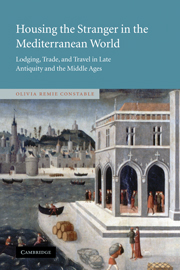 Housing the Stranger in the Mediterranean World
Housing the Stranger in the Mediterranean World Published online by Cambridge University Press: 27 August 2009
Felix Fabri, like many other German pilgrims, passed through Venice on his way both to and from the Holy Land. This city served as a natural gateway to the Adriatic and Mediterranean for travelers and traders coming south from cities of the German empire. Felix stayed in an inn (hospitium) during his time in the island city in the 1480s, but he remarked that “the German merchants have a house in Venice that is called a fonticum. It has many rooms and bedrooms in which merchants stay and store their goods. It is unbelievable how much merchandise is sent from this fonticum to Germany, and each year Venice levies more than twenty thousand ducats in taxes (pro telonio) on these exports.” It should not be surprising that Felix's description of the Venetian Fondaco dei Tedeschi (fonticum Almanorum) is reminiscent of his notes on the European fondacos that he observed in Alexandria. Certainly, the existence of this commercial and residential fondaco for German traders in Venice was no coincidence. Instead, as this chapter will demonstrate, it was just one example of the multiple ways in which the Islamic institution of the funduq/fondaco was integrated into medieval Christian urban life in Mediterranean Europe.
By the thirteenth century, cognate words such as fonticum and fondacho had found their way not only into Latin, but also into other southern European vernacular languages.
To save this book to your Kindle, first ensure no-reply@cambridge.org is added to your Approved Personal Document E-mail List under your Personal Document Settings on the Manage Your Content and Devices page of your Amazon account. Then enter the ‘name’ part of your Kindle email address below. Find out more about saving to your Kindle.
Note you can select to save to either the @free.kindle.com or @kindle.com variations. ‘@free.kindle.com’ emails are free but can only be saved to your device when it is connected to wi-fi. ‘@kindle.com’ emails can be delivered even when you are not connected to wi-fi, but note that service fees apply.
Find out more about the Kindle Personal Document Service.
To save content items to your account, please confirm that you agree to abide by our usage policies. If this is the first time you use this feature, you will be asked to authorise Cambridge Core to connect with your account. Find out more about saving content to Dropbox.
To save content items to your account, please confirm that you agree to abide by our usage policies. If this is the first time you use this feature, you will be asked to authorise Cambridge Core to connect with your account. Find out more about saving content to Google Drive.